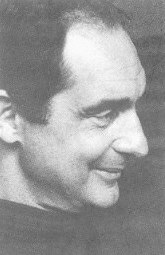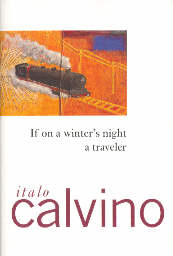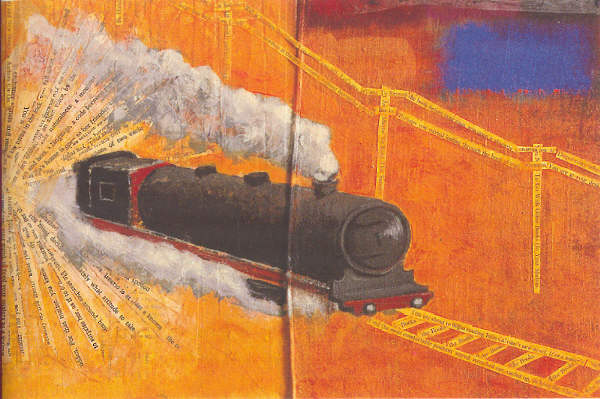The bookseller points Reader to a young lady who had a similar problem with her Calvino: she also got the Bazakal
book, so Reader walks over to meet Other Reader, who, he discovers has never read Bazakal
before, either. They meet, exchange phone numbers, and Reader heads for home to read his new
book, only to discover that its pages are uncut. This has happened to me, but usually it's only a few
uncut pages due some pages missing the slicing ram of the bindery. Easily taken care of with a sharp
knife. So Reader cuts the book open only to be surprised by Bazakal's book, Outside the town
of Malbork:
[page 33] Then from the very first page you realize that the novel you are holding has
nothing to with the one you were reading yesterday.
So I, the me writing this review, turn to page 34 to find a chapter titled, Outside the town of
Malbork ! This is the part where I spent a lot of time inspecting the book and its curious chapter arrangement
which alternated between [number] and Chapter Title. This continues on to the end of the book,
the pattern breaking only at "Chapter [11]" and "Chapter [12]".
In each numbered chapter, something happens to the book Reader is reading or to Reader
himself, so that he is unable to continue reading the story he was engrossed in, and he is somehow introduced to, stumbles upon, or gets interested in a lost book newly arisen from the ashes, like
Without fear of wind or vertigo.
[page 76] You immediately realize that you are listening to something that
has no possible connection with Leaning from the steep slope or Outside
the town of Malbork or even with If on a winter's night a traveler. You
exchange a quick glance, you and Ludmilla(2), or rather, two glances: first
questioning, then agreeing. Whatever it may be, this is a novel where, once
you have got into it, you want to go forward, without stopping.
At one point in Without fear of wind or vertigo Reader imagines himself and
Ludmilla flying as if "suspended over a precipice. . ."
[page 82 ] Perhaps it is this story that is a bridge over the void, and as it
advances it flings forward news and sensations and emotions to create a
ground of upsets both collective and individual in the midst of which a path
can be opened while we remain in the dark about many circumstances both
historical and geographical.
If this seems to be talking about the latest Breaking News on FOX or CNN, it may be a
coincidence, or perhaps it is synchronicity, that is, a coincidence with a pedigree or royal title.
As Reader discovers a French book, Looks down in the gathering shadow, he is shown a
letter and told to read it:
[page 101] "What does the name of an author on the jacket matter? Let
us move forward in thought to three thousand years from now. Who knows
which books from our period will be saved, and who knows which authors'
names will be remembered? Some books will remain famous but will be
considered anonymous works, as for us the epic of Gilgamesh; other
authors' names will still be well known, but none of their works will survive,
as was the case with Socrates; or perhaps all the surviving books will be
attributed to a single, mysterious author, like Homer."
This is a meditation for any Reader or Writer to undertake. It's like we writers(3) are each but lowly
bricklayers adding one brick to a large construction, say, in the early days of construction, where
we can only see a wall as high as our shoulders. If asked, what can we say we are doing? One
worker might say, "I am just laying bricks." The next worker in line might say, "I am building a
great cathedral." The first worker will feel distraught after reading the above passage [page 101]; the second
worker will feel pride and accomplishment. Is it not an individual choice how we can feel? Even
the prisoner bound in chains in a deep dungeon has a choice as to how they feel about their lot: they
can feel trapped or fly on the wings of angels over the prison's walls in their imagination.
In Ludmilla's apartment, the Reader meets a friend of hers who makes books. That is, he uses
books as raw material for his artworks.
[page 149] "I make things with books. I make objects. Yes, artworks:
statues, pictures, whatever you want to call them. I even had a show. I fix
the books with mastic, and they stay as they were. Shut, or open, or else
I give them forms, I carve them, I make holes in them. A book is a good
material to work with; you can make all sorts of things with it."
Later we are not surprised that the very book, that Reader was so intent on finding, ends up with its
only copy being chopped and frozen into an artwork of this friend of Ludmilla. This leads him
to be ensnared In a network of lines that intersect, a chapter title which might bring up in your mind
the idea of a kaleidoscope or the " 'polydyptic theater', in which about sixty little mirrors line the
inside of a large box which can transform a bough into a forest, a miniature lead soldier into an army, a booklet into a
library." Seems innocuous enough, until one connects the work of the masters of the economic
engine known as "derivatives" which led to near total economic collapse in 2008 as portrayed in
the 2011 movie, "Too Big To Fail," which by dint of one of those coincidences with a pedigree,
I had watched the night before I read this next passage. It seems that what Italo Calvino was
writing about in the mid-1970s (in this book) was already coming into being in the levels of higher
finance, a house of cards, a kaleidoscope of lines that intersect, but which can all collapse if the
prices of housing were ever to go down, which they did, precipitously in the 1980s, exactly as the price of
tulips went down a century or so earlier. This time it was the taxpayers, not the investors who took
it in the shorts!
[page 162, 163] The businessmen to whom, before meetings, I show the
collection glance with superficial curiosity at these bizarre apparatuses.
They don't know that I have built my financial empire on the very principle
of kaleidoscopes and catoptric instruments, multiplying, as if in a play of
mirrors, companies without capital, enlarging credit, making disastrous
deficits vanish in the dead corners of illusory perspectives. My secret, the
secret of my uninterrupted financial victories in a period that has witnessed
so many crises and market crashes and bankruptcies, has always been
this: that I never thought directly of money, business, profits, but only of
the angles of refraction established among shining surfaces variously
inclined. . . . I am a man with many enemies, whom I must constantly
elude. When they think they have overtaken me, they will strike only a
glass surface on which one of the many reflections of my ubiquitous
presence appears and vanishes. I am also a man who pursues his numerous
enemies, looming over them and advancing in invincible phalanxes and
blocking their path whichever way they turn. In a catoptric world enemies
can equally believe that they are surrounding me from every side, but I
alone know the arrangement of the mirrors and can put myself out of their
reach, while they end up jostling and seizing one another.
I would like my story to express all this through details of financial
operations, sudden dramatic shifts at board meetings, telephone calls from
brokers in panic, and then also bits of the map of the city, insurance
policies, . . . .
From the text of this novel, one can discern that real Mega-banks, -financial institutions, and -AIG (the ultimate insurance company) were operating in this kaleidoscopic world of illusions which all came collapsing down and all had to be shored up by the Red Queen in Washington, D. C. to prevent another Great Depression. This all happened within the memory of anyone old enough to be reading these words!
Let us go to another prediction, if you can call the above a prediction, to another prediction
by Calvino, that of the Internet and eBook technology. With the Internet someone could be reading
this review I am writing on the polished surface of a laptop or pad. Or I have already published my
review to the Internet, she is reading it, and I am making a change which then instantly appears on
her flat screen. As I make changes to my writing, a process I call playing with sentences, I often
wonder about the possibility that this Other Reader is out there wondering how the text she was
reading suddenly got changed when she returned and refreshed her screen. This was unimaginable
back in the 1970s, and it is reality today.
[page 170] At times I am gripped by an absurd desire: that the sentence I
am about to write be the one the woman is reading at that same moment.
The idea mesmerizes me so much that I convince myself it is true: I write
the sentence hastily, get up, go to the window, train my spyglass to check
the effect of my sentence in her gaze, in the curl of her lips, in the cigarette
she lights, in the shifts of her body in the deck chair, in her legs, which she
crosses or extends.
At times it seems to me that the distance between my writing and
her reading is unbridgeable, that whatever I write bears the stamp of
artifice and incongruity; if what I am writing were to appear on the polished
surface of the page she is reading, it would rasp like a fingernail on a pane,
and she would fling the book away with horror.
Calvino's parable of the two writers, the tormented and the productive writers, should be read
in its entirety. It sounds like a Woody Allen movie. One writes in the morning, one in the afternoon,
and living across from each other in a small valley, they observe the other writer when they are not
writing. They suddenly desire to write the way the other writer writes and do so, creating a novel
which they send to woman who is often seen by them reading in the bottom of the valley in a deck chair. The young
woman reads the two novels and invites the two men to call on her, only to say to them, "What
kind of a joke is it? You have given me two copies of the same novel!" Then Calvino gives us six
alternate version of the same story. (Page 172 to 179)
The copyist, a defunct occupation, provides another amazing insight of Calvino's. The copyist
lives to read while writing, never having to face a lack of words as his pen moves, such as afflicts
many authors, the dreaded writer's block. (Page 178)
On a carpet of leaves illuminated by the moon, Calvino gives us a tantalizingly sexual
episode, as if as a anodyne to relieve the distress of too many words and philosophical concepts
in his recent chapters. The scene consists of a Japanese mother Myagi, her husband Mr. Okeda,
their daughter, Makiko, and a desire sparked by the two women in the narrator of this chapter.
[page 208] Desire that her silk robe, loosened or waiting to be loosened,
now heightened and rewarded as in an explicit offer, so that with Makiko's
apparition in my eyes and Madame Miyagi's contact on my skin I was
about to be overcome by voluptuousness.
Madame Miyagi must have become clearly aware of this, for,
grasping my back, she pulled me down with her on the mat and with rapid
twitches of her whole person she slipped her moist and prehensile sex
under mine, which without a false move was swallowed as if by a sucker,
while her thin naked legs clutched my hips. She was of a sharp agility,
Madame Miyagi: her feet in their white cotton socks crossed at my
sacroiliac, holding me as if in a vise.
My appeal to Makiko had not gone unheard. Behind the paper
panel of the sliding door there was the outline of the girl, kneeling on the
mat, moving her head forward, and now from the doorway her face
appeared, contracted in a breathless expression, her lips parted, her eyes
widened, following her mother's and my starts with attraction and disgust.
But she was not alone: beyond the corridor, in the opening of another door,
a man's form was standing motionless. I have no idea how long Mr. Okeda
had been there. He was staring hard, not at his wife and me but at his
daughter watching us. In his cold pupil, in the firm twist of his lips, was
reflected Madame Miyagi's orgasm reflected in her daughter's gaze.
The scientist Kekule's day dream of the molecules comprising the compound of benzene
moving around like a snake which finally grabs its own tail in its mouth to create the completed ring
structure of what we now know as benzene. With Kekule's insight, the unique properties of
benzene and its derivative compounds became capable of being understood by chemists. Like
Kekule, I puzzled over the curious double-bond nature of the chapters of this book, every other
one a number with a named title in between. What could this all mean? I pondered for several days
as I read the book. On the day before I completed this book, I wondered in a day-dream reverie
if it might be possible to make one sentence of the various named chapter titles. The book was not
with me and I forgot about the idea. My idea of arranging the titles into one sentence has its roots
in my eighth-grade English class when my teacher Mrs. Dixon gave each an assignment to write a
sentence with each of the 17 words in the textbook exercise. I decided to attempt to make one
complete sentence with all 17 words and succeeded. A similar opportunity came to me recently
when I wrote one sentence using all the empty boxcar words my friend Jeff March had
recommended to be avoided by readers of this EditPros Newsletter.
When I came upon this passage, I realized that I had sussed out Calvino's grand scheme for
tying the book together masterfully in his ending chapter.
[page 258] "If on a winter's night a traveler, outside the town of Malbork,
leaning from the steep slope without fear of wind or vertigo, looks down in
the gathering shadow in a network of lines that enlace, in a network of lines
that intersect, on the carpet of leaves illuminated by the moon around an
empty grave — What story down there awaits its end?"
Keeping in mind the readers who want the happy ending, Calvino has Reader marry Ludmilla
and the two of them are in a big bed reading. Ludmilla closes her book and turns off her light to go
to sleep, asking, "Aren't you tired of reading?" and Reader answers, "Just a moment, I've almost
finished If on a winter's night a traveler by Italo Calvino." (Page 260).
And so have I finished writing my review of If on a winter's night a traveler by Italo
Calvino, and so have you finished reading it, now.






